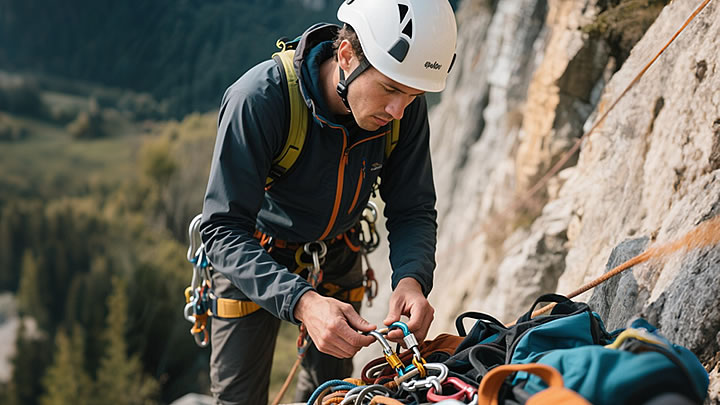What does kN rating mean on climbing carabiners?
If you’ve ever wondered why a tiny carabiner can hold thousands of pounds, the answer lies in its kN rating—a critical but often misunderstood metric. kN (kiloNewtons) quantifies a carabiner’s load-bearing capacity, but its real-world implications go far beyond a single number. Let’s decode the science, standards, and secrets behind these ratings to help climbers make safer choices.

kN 101: The Physics of Force
1 kN equals approximately 225 lbs (100 kg) of force. Carabiners are rated for three load directions:
- Major Axis (Longitudinal): 20-30 kN (4,500-6,700 lbs) – Force applied straight along the spine.
- Minor Axis (Transverse): 7-10 kN (1,500-2,250 lbs) – Force applied sideways.
- Open Gate: 5-9 kN (1,125-2,025 lbs) – Loaded with the gate unlocked.
Why direction matters: A carabiner rated 24 kN longitudinally can fail at just 7 kN if pulled sideways—a 70% strength loss.
How kN Ratings Are Tested
UIAA and CE certification labs simulate worst-case scenarios:
- Static Load Test: Gradually increase force until deformation or failure.
- Gate Open Test: Apply force to a partially open gate (simulates accidental unlocking).
- Cycle Testing: Repeat loading/unloading to simulate wear.
Example: A UIAA-certified carabiner must withstand 20 kN on the major axis without breaking or deforming beyond 5mm.
The Myth of “Higher kN = Safer”
A 30 kN carabiner isn’t inherently safer than a 22 kN model. Consider:
- Climbing forces: Most lead falls generate 3-8 kN. Even severe whippers rarely exceed 12 kN.
- Real-world risks: 92% of carabiner failures stem from misuse (UIAA 2023 data), not kN limits.
- Weight tradeoffs: High-strength steel carabiners (30+ kN) add bulk—a liability on alpine routes.
Choosing kN Ratings by Climbing Discipline
| Climbing Type | Recommended kN (Major Axis) | Rationale |
|---|---|---|
| Sport Climbing | 22-24 kN | Balance of strength and weight. |
| Big Wall/Aid | 25-28 kN | Sustained static loads. |
| Ice Climbing | 24+ kN | Shock loads from tool placements. |
| Via Ferrata | 30+ kN (Steel) | Rescue-level safety margins. |
The Hidden kN Killer: Wear and Corrosion
kN ratings assume a brand-new carabiner. Damage slashes strength:
- Grooves from ropes: Reduces major axis strength by 10-30%.
- Corrosion: Saltwater exposure can halve aluminum’s kN rating.
- Gate wear: A wobbly gate weakens minor axis capacity.
How to “Read” a Carabiner’s Stamp
A typical stamp (e.g., “24 kN ⬆︎ 8 kN ↔ 7 kN 🚪”) decodes as:
- ⬆︎: Major axis (24 kN).
- ↔: Minor axis (8 kN).
- 🚪: Open gate (7 kN).
Pro tip: Brands like Petzl and Black Diamond print icons; budget brands may omit minor/open ratings—avoid them.
kN in Action: Real-World Scenarios
- Anchor Failure: A 15 kN sideways pull (minor axis) on a 24 kN carabiner exceeds its 8 kN rating → snap.
- Gate Mishap: A carabiner rated 7 kN open gate fails when loaded to 6 kN during a fall with a stuck rope.
- Rappel Horror Story: A rusty carabiner’s major axis drops to 12 kN—below the 18 kN force of a static rappel.
Expert Tips for kN-Smart Climbing
- Mix axes wisely: Use two carabiners opposed to convert side loads into longitudinal forces.
- Avoid “magic numbers”: A 22 kN carabiner isn’t “weak”—it’s 4x stronger than most climbing forces.
- Test retired gear: Use a calibrated dynometer to check old carabiners’ actual kN capacity.
The Future of kN Ratings
Innovations on the horizon:
- Smart carabiners: Bluetooth sensors alert users when loads approach kN limits.
- Dynamic kN ratings: Real-time adjustments based on temperature and wear.
- Eco kN metrics: Strength ratings accounting for recycled material durability.
kN ratings are a blueprint—not a guarantee. A carabiner’s true strength lies in the climber’s ability to pair technical knowledge with disciplined use. As legendary climber Yvon Chouinard said: “The best climber is the one having the most fun… and checking their gear twice.”






